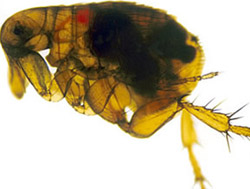 It’s hard to describe the sheer amount of physical discomfort and mental anguish a flea infestation can cause without experiencing one for yourself. Fleas will bite into your skin to draw blood both when you’re sleeping and when you’re awake. Each time a flea bites bites into a host, it releases a small amount of saliva. This often results in an allergic reaction known as flea allergy dermatitis, manifesting a wide range of symptoms like pain, swelling, itching and mild bruising.
It’s hard to describe the sheer amount of physical discomfort and mental anguish a flea infestation can cause without experiencing one for yourself. Fleas will bite into your skin to draw blood both when you’re sleeping and when you’re awake. Each time a flea bites bites into a host, it releases a small amount of saliva. This often results in an allergic reaction known as flea allergy dermatitis, manifesting a wide range of symptoms like pain, swelling, itching and mild bruising.
A stray flea here and there isn’t going to significantly impact your life, but if you see one flea in your home, chances are there are others nearby. A single female can produce over 5,000 eggs in their lifetime, boosting their numbers with little effort.
#1) Vacuum
If you aren’t vacuuming your home on a regular basis, you’re missing out on one of the easiest and most effective ways to treat fleas. According to some studies, vacuuming eliminates up to 96% of adult fleas and 100% of younger fleas. Vacuum every square foot of flooring in your home, paying extra attention to areas of high pet activity (this is where flea populations are the highest).
Use extra caution when emptying the content of your vacuum cleaner to ensure the fleas don’t escape. I recommend emptying it outside where you can safely double-bag it while eliminating the possibility of fleas escaping back into your home.
#2) Lower The Temperature
We talked about this in a previous blog post, but lowering the temperature inside your home can also deter fleas. Fleas require a climate of 70 degrees Fahrenheit of higher to thrive, which is why you rarely see them during the winter. Cooler climates prevent these blood-sucking parasites from completing their normal life cycle.
Dropping your thermostat below 70 degrees will prevent fleas from thriving inside your home. With that said, they may still hatch and reproduce outside and then make their way into your home. If you really want to eliminate fleas once and for all, you must discourage these parasites from inhabiting both inside and outside your home.
#3) Bathe Your Pets
Whether you have a dog or cat (or both), you should get into the habit of bathing them on a regular basis. A once-a-week bath will wash fleas off their coat while encouraging healthier skin. It’s also a soothing way to treat irritation caused by flea bites.
When bathing your pet, use a special dog/cat-formulated anti-flea shampoo. Massage it deep into their coat and let it sit for at least 3-5 minutes before rinsing it out. A generous lather on your pet’s coat will drown any hidden fleas.
